When you think of Netflix, chances are you picture a cozy Friday night, endless scrolling, and that one show you swore you’d stop after just one more episode… only to see the sun coming up.
But here’s the thing:
Netflix isn’t just a streaming app but a global tech giant quietly powering entertainment for over 300 million subscribers (Q1 2025) across 190+ countries.
And the scale?
It’s staggering. We’re talking billions of viewing hours every month and more than a trillion events ingested per day from devices all over the globe (Netflix Engagement Report, 2023). That’s not just “big data”; that’s engineering on a whole different plane.
So how do they pull it off?
The answer lives in a carefully orchestrated blend of distributed systems, cloud-native infrastructure, and clever engineering practices, all tuned to make sure your video starts instantly and stays buttery-smooth no matter where you hit play.
In this case study, we’re pulling back the curtain on Netflix.
Table of Contents
We’ll break down the technical backbone that keeps it fast, reliable, and deeply personalized, from massive data pipelines and microservices to a globe-spanning content delivery network.
But here’s the twist: it’s not just about the tech.
We’ll also look at the engineering culture, mindset, and what you can learn from Netflix.
So, how does the world’s largest streamer build for growth while keeping its promise of instant entertainment, anywhere, anytime?
Let’s get started!
How Netflix’s Architecture Is Structured at a High Level?
Netflix’s architecture is a model of large-scale and distributed system design built for high availability, global scalability, and continuous delivery. At its core, the platform follows a cloud-native microservices architecture, running on Amazon Web Services (AWS) across multiple regions.
This structure allows the platform to support hundreds of millions of users across the world, delivering uninterrupted video streaming, even during peak hours. Moving forward, Netflix is composed of over 1000 loosely coupled microservices, each responsible for a specific function, such as:
- User Profiles
- Billing
- Content Recommendations
- Video Encoding
- Playback
These services communicate asynchronously using APIs, event queues (Kafka), and service discovery mechanisms. This modular design helps Netflix iterate faster, isolate failures, and deploy updates without system-wide impact.
On the frontend, Netflix supports a wide range of devices, from web browsers and smart TVs to mobile apps and gaming consoles. The frontend layer interacts with backend APIs through a GraphQL-based gateway (powered by the Netflix DGS framework), ensuring fast and flexible content delivery.
Simultaneously, Netflix uses a custom content delivery network (CDN) known as Open Connect to serve video content efficiently. Rather than relying entirely on public CDNs, Netflix deploys physical servers within ISPs around the world, minimizing latency and reducing bandwidth costs.
On the infrastructure level, tools like Spinnaker (for continuous delivery), Chaos Monkey (for resilience testing), and Atlas (for telemetry) support Netflix’s DevOps and SRE teams in maintaining platform stability.
Altogether, this high-level design reflects Netflix’s focus on scalability, reliability, and speed, laying the groundwork for every feature the service offers, from instant playback to personalized recommendations.
To better understand how all these moving parts fit together, let’s look at a high-level view of Netflix’s architecture, which brings its core components, such as microservices, DevOps tooling, frontend technologies, data systems, and streaming workflows, into one picture.
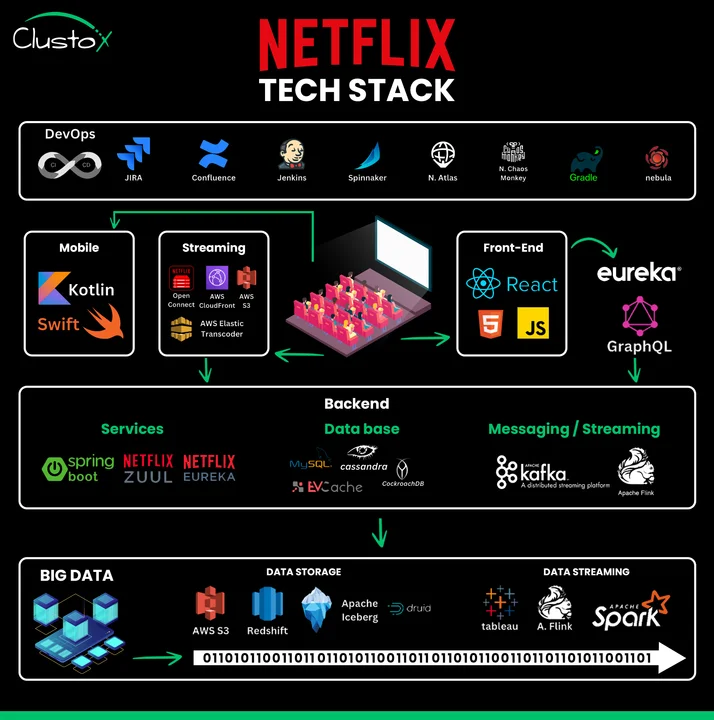
Nevertheless, it’s important to look at the principles that guide its underlying system design to understand why this architecture performs so reliably at scale.
Which Foundational Principles Drive Netflix’s System Design?
Netflix’s architecture is guided by a set of system design principles that prioritize scalability, fault tolerance, and developer velocity. These principles are deeply embedded in every component of its platform, enabling the service to operate at a global scale while maintaining performance and reliability.
In the following, we will take a look at the key system design principles that make this possible:
Microservices over Monoliths
Netflix migrated from a monolithic architecture to a microservices-based model to isolate services, reduce interdependencies, and enable faster deployments.
Resilience by Design
Failure is treated as inevitable, so Netflix engineers for it. The system incorporates techniques like bulkheading, retries, and circuit breakers. Additionally, in 2011, Netflix released Chaos Monkey, a tool that purposefully shuts down production instances to guarantee services continue to function even in the event of unplanned failures, to validate real-world resilience.
Scalability at the Core
Each service is independently deployable and horizontally scalable, allowing the platform to handle spikes in demand without downtime.
Observability and Monitoring
Netflix emphasizes system visibility using telemetry tools like Atlas, enabling engineers to detect, diagnose, and resolve issues in real time.
Loose Coupling with High Cohesion
Services are designed to be loosely coupled but internally cohesive, allowing teams to iterate independently without disrupting the wider system.
The following infographic maps these guiding principles to the tools and technologies Netflix uses to enforce them in practice:
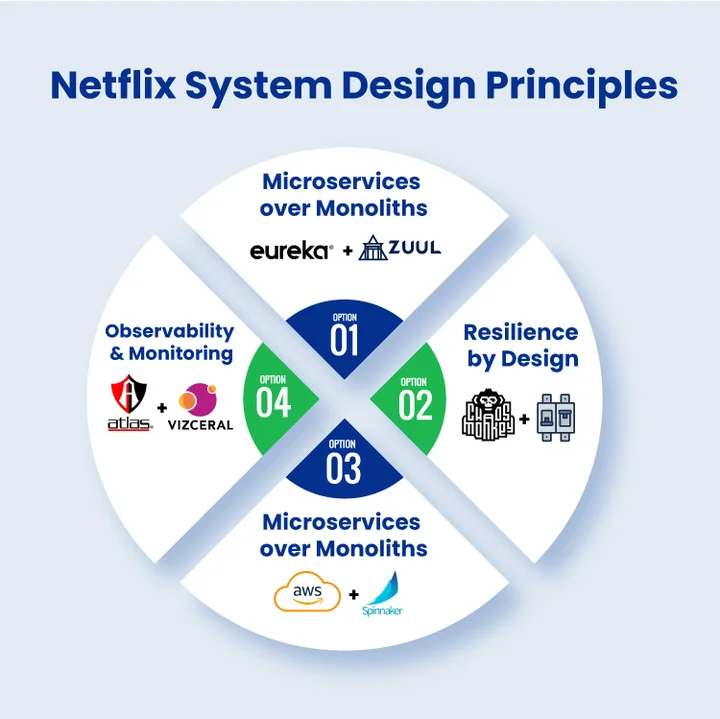
Altogether, these principles help Netflix build and maintain an architecture capable of handling millions of concurrent users across diverse platforms and regions.
Struggling with downtime, scalability limits, or legacy systems? Our cloud architects apply the same principles of resilience and speed to help businesses scale without disruption.
With Netflix’s system design principles in mind, the next step is to explore how these principles are applied across different technical domains. Each layer of Netflix’s architecture, from backend services to video delivery, mobile apps, and data infrastructure, has been engineered to support real-time performance at a massive scale.
Let’s begin with the foundation of it all: the backend infrastructure.
1. Backend Infrastructure: The Foundation of Netflix’s Architecture
To understand how Netflix delivers personalized experiences to millions of users, it’s essential to examine the engine running behind the scenes, its backend infrastructure. This layer powers the core business logic, user authentication, profile management, content recommendations, and real-time playback coordination.
With that big-picture view in mind, we will explore now how the backend is architected and maintained:
Technologies Used in Netflix’s Backend
To meet performance and scalability demands, Netflix built its backend on a cloud-native microservices architecture deployed on Amazon Web Services (AWS). It primarily uses Java with Spring Boot since 2018 for service development and incorporates both internal and open-source tools to streamline service communication and data access.
Some of the core components include:
- Eureka for service discovery
- Zuul and API Gateway for intelligent request routing
- Cassandra and Dynomite for distributed data storage
- DGS (Domain Graph Service) for GraphQL-powered data fetching
- Ribbon for client-side load balancing (historically used)
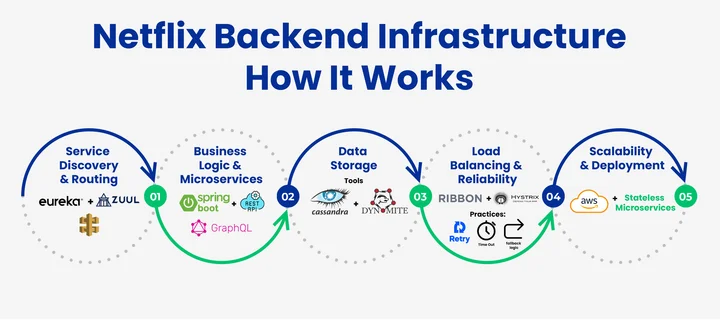
In essence, these technologies work together to ensure high availability, fast response times, and flexible API communication across thousands of microservices.
How Does Netflix Implement Its Backend Architecture?
Taking these technologies a step further, Netflix implements them using patterns focused on scalability, resilience, and failure isolation. Each microservice is stateless and independently deployable, which allows teams to iterate quickly and scale specific services as needed.
Communication between services happens through RESTful APIs and GraphQL, with built-in mechanisms for retries, timeouts, and fallback logic. While Netflix previously used Hystrix for circuit breaking, the architectural principle remains active even after its deprecation, ensuring service faults are contained and do not cascade across the system.
This implementation style directly supports Netflix’s core business goals: zero downtime, rapid innovation, and consistent performance worldwide.
Challenges This Architecture Solves
Netflix successfully tackles a number of challenging engineering issues by building its backend in this manner, such as:
- Scalability: Stateless microservices are horizontally scaled across AWS.
- Reliability: Services are deployed with redundancy and fail-safes.
- Latency: Regional deployments help reduce user-facing response times.
- Flexibility: Teams can ship features independently without risking platform stability.
These solutions are critical for supporting Netflix’s 24/7 global streaming operation and enabling personalized user experiences without compromise.
2. Frontend Engineering at Netflix: Built for Scale and Speed
As one of the most widely accessed streaming platforms on the planet, Netflix must deliver a fast, responsive, and consistent user interface across hundreds of device types, including web browsers, smartphones, smart TVs, set-top boxes, and gaming consoles.
The frontend layer is responsible for everything users interact with, from content carousels to playback controls and must be optimized for performance under highly variable network and hardware conditions.
We’ll examine the technology that supports this flawless user experience below:
Essential Technology Underpinning Netflix’s Frontend
Netflix’s frontend relies on a mix of web, native, and TV-specific technologies to deliver a consistent experience across devices:
- JavaScript & React: Primary stack for Netflix’s web application, enabling dynamic, interactive UIs.
- Gibbon: A lightweight JavaScript framework designed in-house for smart TV applications, optimized for low-power hardware.
- Kotlin (Android) & Swift (iOS): Native mobile app development stacks for optimal device integration and performance.
- Domain Graph Service (DGS): Netflix’s internal GraphQL framework that allows clients to request only the data they need, reducing over-fetching.
- Device-Agnostic UI Model: Separates presentation logic from data and interaction layers, making it easier to update interfaces without breaking compatibility.
The diagram below illustrates how Netflix’s frontend is structured across devices, the technologies powering it, and the performance strategies that keep it fast and flexible:
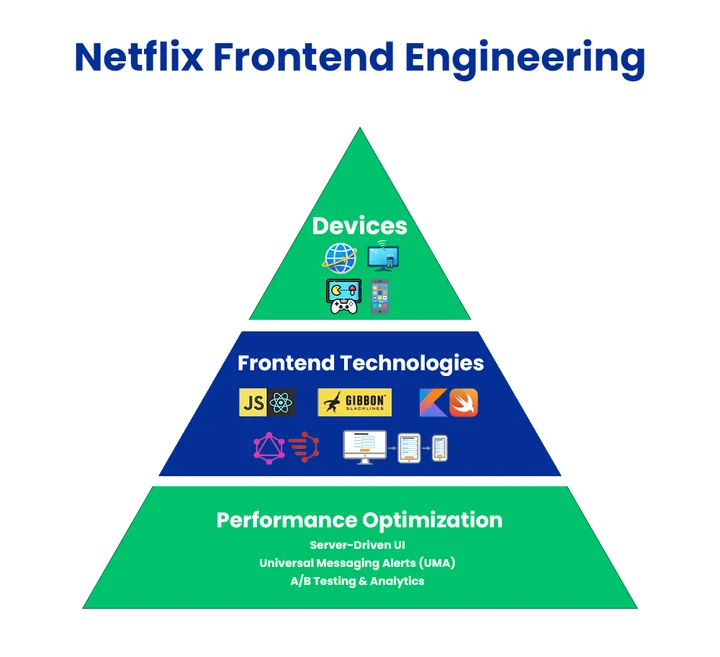
Together, these tools form the foundation of Netflix’s frontend, ensuring updates roll out quickly while maintaining performance across hundreds of device types.
Optimizing for Performance & Flexibility
Netflix goes beyond traditional client-side rendering by using server-driven UI on certain platforms. This approach allows the backend to dictate how content is displayed on different devices, reducing the need for frequent app updates.
Christopher Luu stated at QCon London 2024 that using server-driven UI for its universal messaging alerts (UMA) system, Netflix can push cross-platform UI changes via JSON without requiring app store releases.
In other words, when combined with A/B testing frameworks and real-time analytics, server-driven UI empowers Netflix to experiment continuously, optimize layouts, and refine engagement strategies without user disruption.
As a result, Netflix makes sure that billions of users have a seamless viewing experience regardless of the screen they are using by designing its frontend with performance, modularity, and flexibility in mind.
3. Netflix’s Mobile Architecture for Android and iOS
With many users accessing Netflix via smartphones and tablets, mobile engineering is a mission-critical domain. Netflix’s mobile architecture optimizes battery consumption and load times, manages playback in erratic network environments, and provides a top-notch experience across a range of hardware and operating systems.
Now, we will explore how Netflix achieves this natively on both platforms while staying in sync on goals:
Platform-Specific Development with Shared Goals
Netflix develops its Android app using Kotlin and its iOS app in Swift, ensuring native performance and full access to platform capabilities. Despite separate codebases, the engineering philosophy across both platforms remains consistent:
- Prioritize fast startup times and smooth UI transitions.
- Handle offline playback and bandwidth adaptation efficiently.
- Ensure scalability across a range of devices, from low-end phones to flagship models.
The visual below compares Netflix’s Android and iOS mobile stacks while highlighting the shared goals and optimization strategies that keep the experience consistent across platforms:
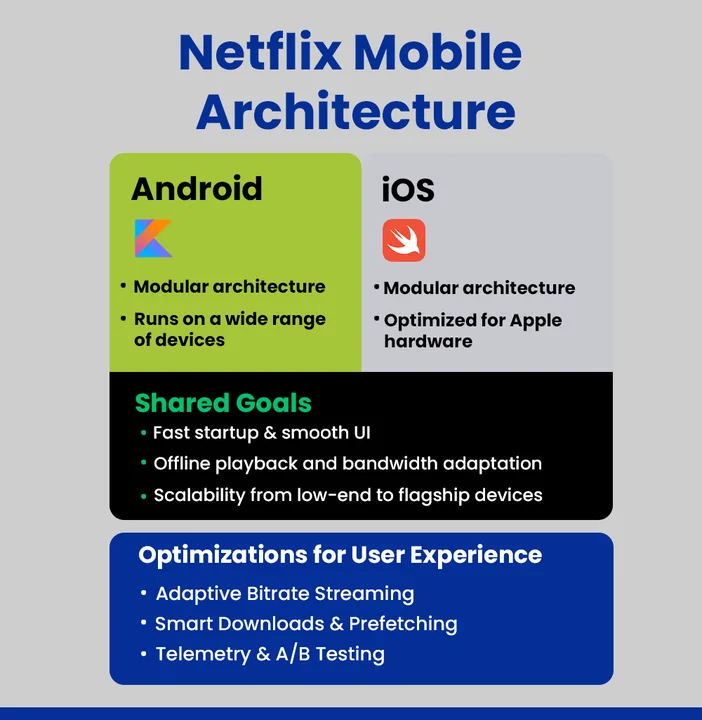
To support this, Netflix uses a modular architecture, allowing teams to develop and iterate on features, like downloads, recommendations, or search, independently, which improves agility and reliability.
With architecture in place, we will now discuss how Netflix optimizes playback and user experience:
Optimizing Playback and User Experience
One of Netflix’s mobile priorities is adaptive bitrate streaming, which adjusts video quality based on real-time bandwidth and device conditions. This minimizes buffering while conserving mobile data. Additionally, features like Smart Downloads and background prefetching are engineered to improve user engagement in regions with limited connectivity.
Mobile engineers at Netflix also rely heavily on telemetry and A/B testing, allowing them to test features at scale, monitor performance, and quickly resolve regressions across global user segments.
Consequently, Netflix ensures that its mobile apps offer the same reliability and polish as its web and TV platforms, regardless of region, network speed, or device.
4. Microservices: The Netflix Approach
Microservices are at the core of how Netflix builds and operates its global platform. Rather than relying on a single monolithic codebase, Netflix has decomposed its system into over a thousand independent microservices, each handling a specific business function, such as user authentication, playback control, recommendations, or billing.
This modular approach allows teams to develop, test, and deploy features autonomously, which contributes to Netflix’s ability to release changes rapidly and reliably.
Patterns and Tools for Microservice Management
To orchestrate this scale, Netflix has built and open-sourced a number of tools that support service discovery, routing, and resiliency:
- Eureka: Handles service registration and discovery
- Zuul (replaced by Zuul 2): Serves as an API gateway for routing requests
- Ribbon (historically used): Load balancing within services
- Archaius: Dynamic configuration management
- Hystrix (now deprecated): Circuit breaker pattern for fault isolation
The visual below illustrates Netflix’s microservices ecosystem, showing how thousands of independent services communicate while being supported by orchestration tools and resilience practices:

Each service is stateless, making it horizontally scalable and easier to recover or replace in case of failure.
Even with this modular architecture, Netflix tackles real-world challenges head-on using advanced observability and resiliency strategies.
Solving Real-World Challenges with Microservices
Operating microservices at this scale introduces complexity, observability issues, and inter-service communication overhead. Netflix addresses these with:
- Comprehensive telemetry and real-time alerts for proactive monitoring.
- Chaos engineering practices (like Chaos Monkey and its broader Simian Army) to validate system resilience under failure conditions.
- Automated orchestration tools like Netflix Conductor for managing microservice workflows at scale.
As a result, Netflix can innovate quickly, maintain service reliability, and support a vast number of devices and regions, all while delivering personalized content seamlessly to millions.
5. Netflix Cloud Infrastructure and DevOps Culture
To operate at the scale Netflix does, serving over 230 million users globally across mobile, web, smart TVs, and game consoles, a conventional IT setup wouldn’t suffice.
Their secret?
A cloud-first strategy and a deeply ingrained DevOps culture that work together to ensure scalability, resilience, and developer autonomy.
As Netflix expanded to serve over 190 countries, building a platform that could scale effortlessly while also staying resilient in the face of failure became a mission-critical goal.
Here is how Netflix made this powerful shift possible:
Netflix’s Cloud Migration Journey
Following a critical database corruption in 2008, Netflix began migrating away from monolithic infrastructure to a fully cloud-native architecture on AWS. This multi-year transition wasn’t just a lift-and-shift. It involved rethinking architecture for cloud elasticity and service-oriented design.
Netflix completed its cloud migration in early January 2016 after seven years of work, truly transforming into a cloud-native platform.
This enabled:
- Rapid provisioning of compute using 10,000+ EC2 instances
- Multi-region deployment for global content delivery
- Elastic scaling during traffic spikes (e.g., new season releases)Hystrix (now deprecated)
- Disaster recovery by design
This foundational shift lets teams focus on building features, not managing hardware.
DevOps Culture: Autonomy, Speed, and Accountability
Unlike traditional organizations that silo operations, Netflix hands engineers full control of their services, including deployments to production. Their motto: “Freedom and Responsibility.”
This works because:
- Teams build, deploy, and monitor their own code.
- Guardrails like automated canary releases, rollback triggers, and real-time telemetry reduce risk.
- Failure is normalized through testing, not feared.
This lets developers confidently push hundreds of changes per day without compromising system stability.
Next, we will see the tools, both open-source and in-house, that power this ecosystem.
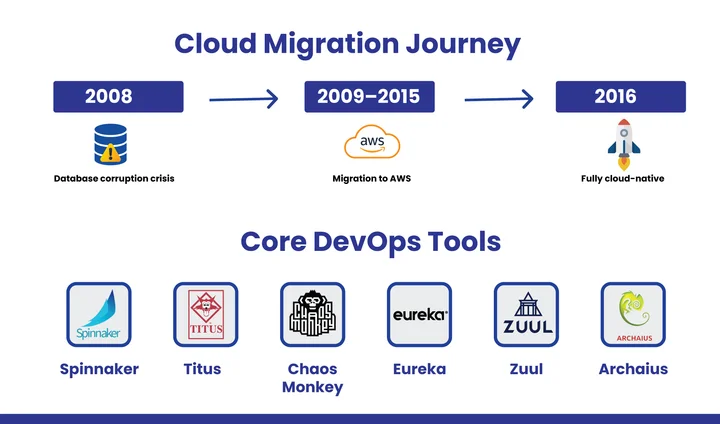
Tools That Power It All
Despite using industry tools, Netflix also develops a lot of its own:
- Spinnaker: Open-source multi-cloud CI/CD platform used to deploy code safely and consistently
- Titus: Container management platform integrated with AWS
- Chaos Monkey: Part of the Simian Army, intentionally kills instances to test system resilience
- Eureka, Zuul, and Archaius: Tools for service discovery, routing, and configuration
These systems work together to support a highly available and self-healing architecture.
When combined, Netflix’s cloud and DevOps strategy aim to facilitate innovation without impediments rather than merely managing scale. This foundation supports rapid experimentation, fault tolerance, and continuous delivery, which are essential for a company that must operate globally, 24/7, without interruptions.
Netflix’s cloud-first shift shows why fragile setups and slow releases fail at scale. Our DevOps experts help businesses design cloud foundations built to last.
6. Databases & Caching: How Does Netflix Handle Data at Scale?
To appreciate how Netflix maintains such a responsive user experience across devices and continents, it’s important to look at how they manage data at the core level. This involves not just how data is stored, but how quickly and reliably it can be accessed.
Let’s start with how Netflix enables global access to data.
Distributed Data Storage for Global Access
At the foundation of Netflix’s backend lies Apache Cassandra, a distributed NoSQL database system built for availability and fault tolerance. Given the platform’s global user base, Cassandra enables Netflix to store data across multiple regions and availability zones.
In other words, rather than relying on a single data center, Netflix uses regionally replicated clusters that help maintain uptime and quick response times, even during localized failures. This masterless design ensures that any node can serve read/write requests, which is critical when scaling for millions of concurrent users.
Moreover, Cassandra’s architecture fits seamlessly with Netflix’s microservices model, where decentralized data ownership is the norm.
Caching for Performance Optimization
While databases secure persistent storage, caching significantly boosts performance by enabling quicker access to frequently used data. Netflix’s custom caching layer, EVCache (built on Memcached), handles data like watch history, session metadata, and personalized recommendations to ensure fast retrieval.
Aside from speed, EVCache offers global reliability, too.
Here’s how EVCache excels:
- Global Replication: Caches are replicated across regions, mitigating “cold cache” issues during traffic shifts.
- High Cache Hit Rates: Most services, like “Similars,” achieve hit rates above 99.9%.
- Optimized Bandwidth: Techniques like batch compression reduce replication bandwidth usage by approximately 35%.
- Features like TTL Policies and Edge Caching: Keep cached data fresh and ensure fast delivery via edge servers.
Balancing Consistency and Availability
Lastly, Netflix takes a pragmatic approach to consistency. For most user-facing operations, eventual consistency is sufficient. However, for areas like billing or account security, stronger consistency guarantees are applied using transactional systems.
The diagram below compares how Netflix combines distributed databases (for global durability) with EVCache (for speed and reliability), striking the balance required for scale:
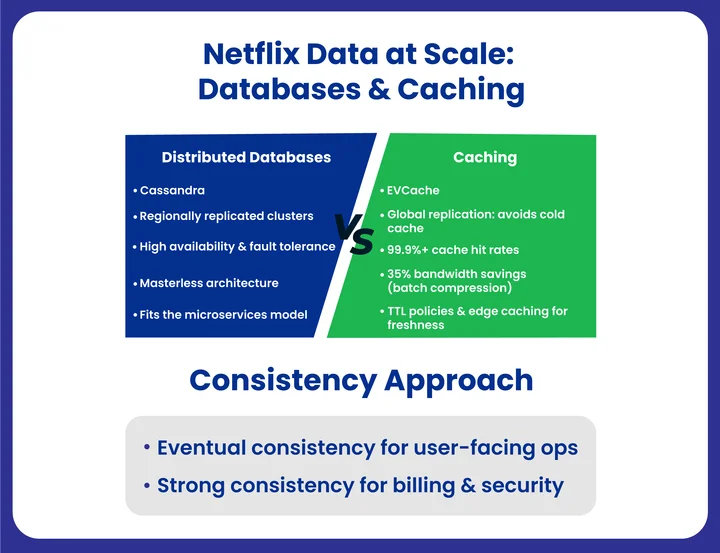
In essence, Netflix effectively strikes a balance between scale, speed, and reliability, three fundamental components of its architecture, by integrating distributed databases with strategic caching.
7. Netflix’s Video Workflow: Encoding, Storage & Streaming
As we transition from how Netflix manages its data layer, it’s time to look at what the platform is best known for: video. At its core, Netflix is a video delivery system and ensuring billions of playback sessions happen without buffering or quality drops is no small feat.
Device-Specific Encoding
To serve content to users across varying network conditions and screen sizes, Netflix employs per-title encoding. Instead of using a one-size-fits-all bitrate ladder, Netflix analyzes each video asset and generates multiple encoding profiles tailored to its complexity.
This helps:
- Minimize bandwidth usage.
- Preserve visual quality.
- Adapt to device-specific requirements.
The result?
Viewers get the best possible experience, no matter if they are on a 4K TV or a low-bandwidth mobile connection.
Globally Distributed Storage: Netflix’s Content Delivery Backbone
After encoding, content is distributed to Open Connect Appliances (OCAs), Netflix’s custom-built CDN servers. These are deployed across ISPs globally and cache popular content closer to users.
This edge caching model:
- Reduces latency
- Improves load times
- Minimizes backbone bandwidth usage
In fact, Analysys Mason reported that OCAs now number in the thousands, are deployed with over 1,000 ISPs, and have helped save ISPs over USD 1 billion in 2021.
Adaptive Streaming for Smooth Playback
Finally, once the content reaches you, the playback experience stays smooth thanks to adaptive streaming. Netflix uses standards like MPEG-DASH and HLS, which break video into chunks and let the client adaptively switch bitrates based on real-time network conditions.
In practice, that means if your connection dips, the player seamlessly downgrades quality, and when bandwidth improves, it upgrades, so buffering becomes a thing of the past.
The diagram below illustrates Netflix’s video workflow, from per-title encoding to global CDN distribution to adaptive streaming that guarantees smooth playback:
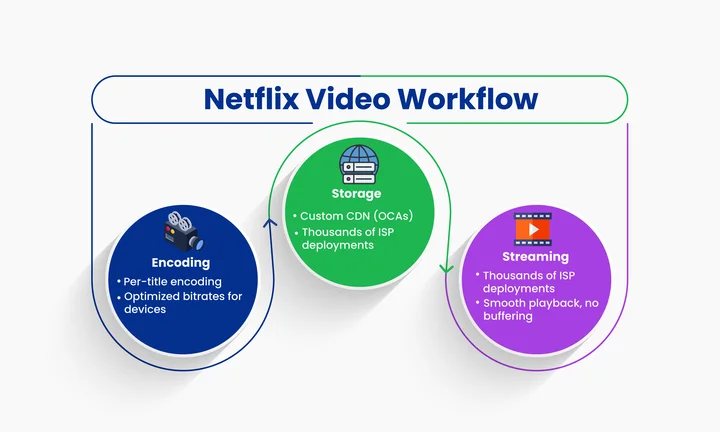
8. Messaging & Real-Time Streaming at Netflix
To operate a platform serving hundreds of millions globally, Netflix needs a messaging and real-time streaming infrastructure that’s fast, reliable, and capable of handling massive volumes of data.
To put it simply, this part of the architecture plays a pivotal role in real-time personalization, stream health monitoring, and system-wide observability.
Before we understand how Netflix does it, it’s important to understand why this layer of the architecture matters so much.
Why Do Messaging and Real-Time Streaming Matter?
When a viewer hits “Play,” a flurry of events unfolds behind the scenes: logging playback data, adjusting bitrate in real time, and more. To manage all this, Netflix has built a high-throughput messaging backbone that enables fast, asynchronous communication across microservices.
In fact, Netflix processes billions of real-time events every day through an event-driven architecture, allowing services like recommendations, analytics, and playback systems to react asynchronously and at scale.
Netflix’s Key Technologies for Real-Time Messaging
With that foundation in mind, we will look at the core technologies that keep Netflix’s real-time messaging engine running smoothly:
- Apache Kafka: The core of Netflix’s event streaming platform, handling trillions of messages per day across services.Analysys Mason reported that
- Apache Flink: Used for real-time stream processing and computing aggregations or alerts on live data.
- Apache Iceberg: Helps manage huge volumes of analytical tables on object storage with support for streaming and batch workloads.
- DynamoDB Streams: Facilitates real-time change data capture and event propagation across services.
The infographic below shows how these tools fit together in Netflix’s real-time messaging backbone:
Now that we know the tools, the next step is to understand how Netflix coordinates them for massive-scale event delivery.
Coordinated Event Delivery for Scale
Netflix ensures delivery consistency, either exactly once or at least once, based on the specific use case. Kafka’s partitioned design allows the system to scale horizontally, while Flink delivers real-time processing capabilities like windowed joins and aggregations crucial for low-latency reactions.
All together, these systems form the backbone of Netflix’s event-driven architecture, enabling services to communicate efficiently and act on events in near real time.
9. Netflix’s Data Infrastructure: The Backbone of Personalization and Scale
As we continue to break down the architecture of Netflix, one of the most critical yet often overlooked components is its data infrastructure. But in reality, this system doesn’t just support the platform’s performance; it actively drives the user experience, content strategy, and operational efficiency.
In the following, we will analyze how Netflix manages the massive amount of data it collects:
Massive-Scale Data Ingestion and Event Tracking
Netflix generates and ingests over a trillion events per day from its global network of devices and services. These include user interactions like play/pause behavior, content search patterns, streaming quality metrics, and device diagnostics.
All of it funnels into a distributed, event-driven pipeline based on Apache Kafka, designed to meet the platform’s high-throughput and low-latency demands. In fact, Netflix’s Keystone pipeline processes up to 2 trillion messages per day, with around 3 petabytes of data ingested and 7 petabytes output daily.
Next, we’ll explore how they manage both long-term insights and real-time reactions.
Hybrid Processing Model: Batch + Real-Time
To serve diverse purposes, Netflix supports both batch and stream processing. They use Apache Spark for large-scale, offline tasks like training recommendation models or analyzing long-term trends. Meanwhile, tools like Apache Flink handle real-time data processing for near-instant personalization and analytics; you get tailored results, fast.
Moving forward, let’s discuss where all this data goes:
Data Lakes, Warehousing, and Governance
All collected data flows into central repositories. Netflix builds on Amazon S3 as its data lake and uses Trino (formerly Presto) for efficient querying across massive datasets. Behind the scenes, their internal platform Keystone also plays a role in managing schemas, metadata, lineage, and data governance. This ensures high data quality, traceability, and compliance across all operations.
Finally, we’ll look at how this infrastructure promotes personalization and innovation.
Enabling Personalization and Experimentation
With such rich, well-governed data, Netflix continuously trains and deploys machine learning models that personalize everything: UI layouts, carousels, search results, and more. This data ecosystem also supports thousands of simultaneous A/B tests, letting teams refine features, thumbnails, trailers, and even pricing strategies per region.
The overview below brings Netflix’s data infrastructure into focus, showing how data flows from ingestion to personalization and experimentation at scale:
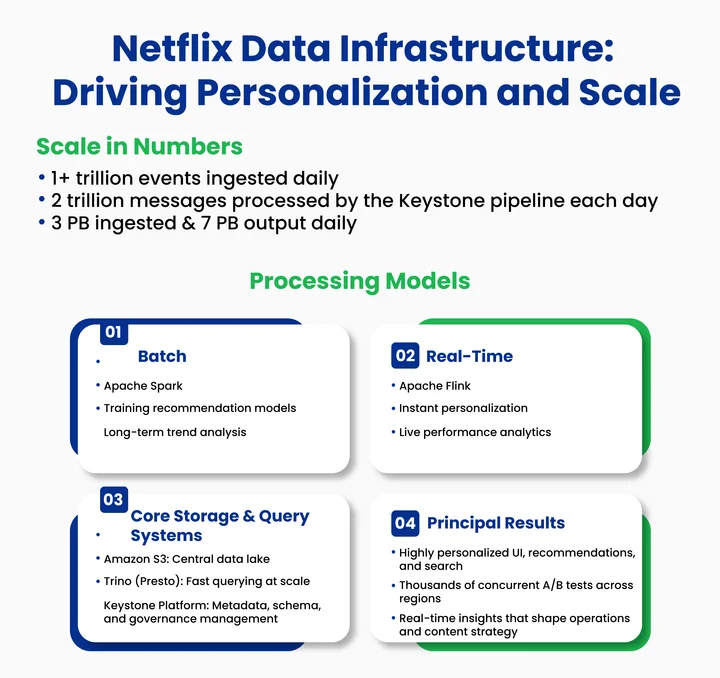
Putting it all together, Netflix’s data infrastructure is more than a technical achievement; it’s a business enabler that empowers real-time decisions, fuels innovation, and keeps the platform highly responsive to how users behave across the globe.
Netflix turns trillions of daily events into personalization and insights. If your data isn’t driving results, our team can build the infrastructure to change that.
What Teams Can Learn from Netflix’s Engineering Culture?
Netflix’s platform is admired for its performance, scalability, and fault tolerance, but replicating it blindly can do more harm than good. Instead, companies should analyze what elements are worth applying and which are best left alone.
In the following, we explore the key lessons, cultural elements, and practical tools that modern engineering teams, both at startups and enterprises, can draw from Netflix.
Lessons Engineering Teams Can Apply
While not every organization needs to operate at Netflix’s scale, several practices are widely adaptable:
- Invest in Observability: Netflix built powerful tools like Vizceral, Atlas, and Edda to gain deep visibility into system behavior. Smaller teams can start with simplified observability stacks that reflect this commitment to system insight.
- Design for Failure: Tools such as Chaos Monkey teach engineers to plan for the unexpected, instilling resilience by randomly disabling production servers to test fault tolerance.
- Embrace Microservices Carefully: Netflix’s success with microservices stems from its robust internal tooling and culture. However, premature adoption can burden smaller teams with complexity and operational overhead.
Next, here’s what you might want to reconsider or adapt cautiously:
What Not to Copy Blindly?
Netflix’s architecture was built after years of growth, supported by a large engineering team and mature DevOps culture. Additionally, scaling like Netflix isn’t always necessary. Thus, startups may benefit more from simplicity and monolithic architecture in early stages.
Then, let’s explore the cultural elements that enable Netflix’s innovations.
Cultural Insights: Freedom, Responsibility, and Open Source
Beyond tooling, Netflix’s culture, “freedom and responsibility,” gives engineers autonomy with accountability. This trust-driven model isn’t for every company but offers a glimpse into how high-performing teams can thrive.
Netflix also shares its innovations via open-source Spinnaker, Zuul, Eureka, and more, making their learnings accessible across the industry.
All in all, understanding not just how Netflix builds but why helps teams borrow what aligns with their context without overengineering or overextending. Approached thoughtfully, these takeaways can guide smart architectural, tooling, and cultural decisions that drive innovation and resilience.
The visual below summarizes Netflix’s most adaptable lessons and cultural insights for engineering teams of any size:
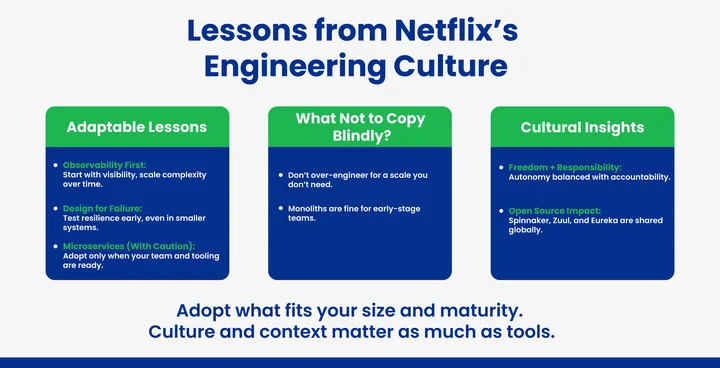
Conclusion: Insights from Netflix’s Scalable Architecture
In summary, Netflix’s architecture showcases how thoughtful engineering can support massive scale and global reach. Netflix strikes a balance between complexity and efficiency with its microservices approach, smart data management, and resilient infrastructure.
Moreover, their culture of continuous improvement and focus on automation ensures the platform remains reliable under heavy loads.
It is important to note that this case study shows that following Netflix’s model does not mean simply copying everything; rather, it involves comprehending the design principles and modifying them to suit your own requirements. For instance, modular services, fault tolerance, and observability are pillars worth considering.
Similarly, Clustox engineers design Java-based microservices for enterprise applications with strong support for CI/CD pipelines, observability, and service isolation. In this way, we embrace many of the same pillars Netflix uses to build scalable, reliable systems tailored to our clients’ needs.
Ultimately, Netflix is a brilliant engineering example of how to build systems that scale gracefully. Therefore, teams aiming for growth can learn valuable lessons on building resilient, flexible, and performant applications by exploring these practices.
Frequently Asked Questions (FAQs)
How Does Netflix Balance Cost Efficiency With Global Scalability?
Netflix controls costs by deploying its Open Connect CDN appliances directly inside ISPs, reducing backbone bandwidth charges and optimizing data delivery. It also leverages auto-scaling on AWS, ensuring compute resources scale up during peak traffic but contract when demand drops. This combination of cloud elasticity and localized content delivery helps Netflix stay efficient while serving billions of viewing hours monthly.
Why Did Netflix Move to the Cloud and What Were the Benefits?
After a database crash in 2008, Netflix migrated to a cloud-native AWS architecture for scalability and resilience. This shift allowed rapid provisioning of 10,000+ EC2 instances, multi-region deployments for global delivery, and elastic scaling during peak traffic (like season launches). Today, Netflix’s cloud-first strategy and DevOps culture enable continuous delivery, fault tolerance, and innovation without the limitations of physical data centers.
What Lessons Can Businesses Learn From Netflix’s DevOps and Engineering Culture?
The most valuable takeaway from Netflix is its “freedom and responsibility” model, where engineers own the entire lifecycle of their services. With tools like Spinnaker for CI/CD, Chaos Monkey for resilience testing, and real-time observability platforms, teams deploy hundreds of changes daily without fear of failure. For businesses, the lesson is clear: combining DevOps culture, automation, and resilience engineering fuels innovation while maintaining reliability.
How Does Netflix Handle Customer Support at a Global Scale?
Beyond technology, Netflix invests in AI-powered support chat, multilingual customer service teams, and self-service help portals. Support systems are integrated with telemetry data, meaning agents and bots can identify issues like device errors or streaming quality problems in real time. This global-first support model helps Netflix maintain high customer satisfaction across 190+ countries.
Netflix proves scalable systems blend smart engineering with strong culture. If you need resilient, cloud-native architecture, our engineers are ready to deliver results.

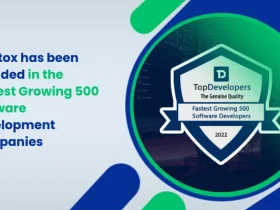
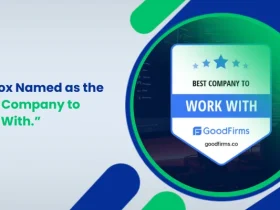

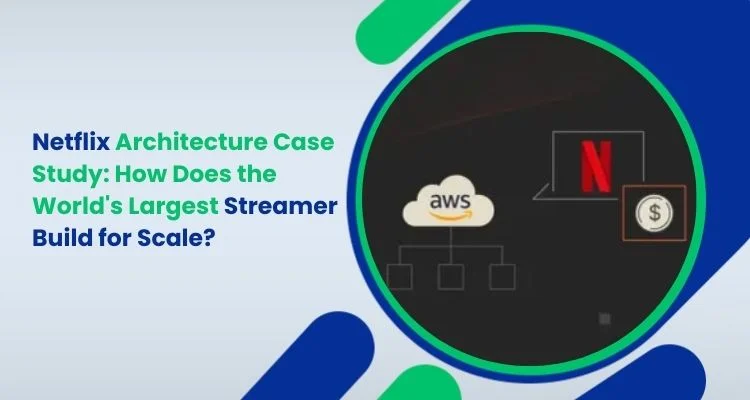
Share your thoughts about this blog!